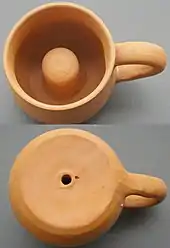Pythagorean cup
A Pythagorean cup (also known as a Pythagoras cup, Greedy Cup, Cup of Justice, Tantalus cup or i koupa tis dikaiosynis) is a practical joke device in a form of a drinking cup, credited to Pythagoras of Samos. When it is filled beyond a certain point, a siphoning effect causes the cup to drain its entire contents through the base.

Form and function

A Pythagorean cup looks like a normal drinking cup, except that the bowl has a central column in it, giving it a shape like a Bundt pan. The central column of the bowl is positioned directly over the stem of the cup and over a hole at the bottom of the stem. A small open pipe runs from this hole almost to the top of the central column, where there is an open chamber. The chamber is connected by a second pipe to the bottom of the central column, where a hole in the column exposes the pipe to (the contents of) the bowl of the cup.[1]
When the cup is filled, liquid rises through the second pipe up to the chamber at the top of the central column, following Pascal's principle of communicating vessels. As long as the level of the liquid does not rise beyond the level of the chamber, the cup functions as normal. If the level rises further, however, the liquid spills through the chamber into the first pipe and out of the bottom. Gravity then creates a siphon through the central column, causing the entire contents of the cup to be emptied through the hole at the bottom of the stem.[2] Most modern toilets operate on the same principle: when the water level in the bowl rises high enough, a siphon is created, emptying the bowl.

See also
- Dribble glass
- Fuddling cup
- Heron's fountain
- List of practical joke topics
- Puzzle jug
- Soxhlet extractor, which uses the same mechanism.
- Qiqi
References
- "Physics demonstrations: the Pythagoras cup". skullinthestars.com. 2012-04-26. Retrieved 2015-01-30.
- "Pythagorean cup - The Theory". EP Magazine. 2008. Retrieved 2015-01-30.
External links
| Wikimedia Commons has media related to Pythagoras cup. |